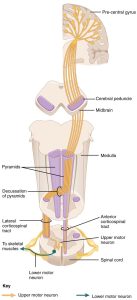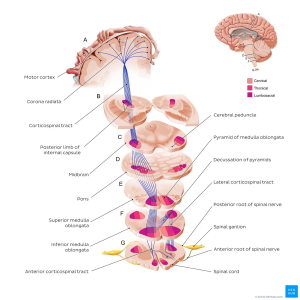
 The corticospinal tract is a white matter motor pathway starting at the cerebral cortex that terminates on lower motor neurons and interneurons in the spinal cord, controlling movements of the limbs and trunk.
The corticospinal tract is a white matter motor pathway starting at the cerebral cortex that terminates on lower motor neurons and interneurons in the spinal cord, controlling movements of the limbs and trunk.
The primary purpose of the corticospinal tract is for voluntary motor control of the body and limbs.
There are more than one million neurons in the corticospinal tract.
Most neurons in th corticospinal tract become myelinated in the first two years of life.
The corticospinal tract is one of the pyramidal tracts, the other being the corticobulbar tract.
The corticospinal tract originates in several parts of the brain including: the motor areas, but also the primary somatosensory cortex and premotor areas.
Most corticospinal neurons originate in the primary motor cortex (precentral gyrus, Brodmann area 4) or the premotor frontal areas.
The corticospinal tract has 2 divisions:
the anterior and lateral tracts.
About 30% of corticospinal neurons originate the lateral corticospinal tract and the anterior corticospinal tract.
The lateral corticospinal tract neurons cross the midline at the level of the medulla oblongata, and controls the limbs and digits.
The lateral tract forms about 90% of connections in the corticospinal tract.
The vast majority of lateral tract connections cross over in the medulla, while about 2-3% remain ipsilateral.
The anterior corticospinal tract neurons, the remaining 10%, stay ipsilateral in the spinal cord but decussate at the level of the spinal nerve in which they exit, and control the trunk, shoulder and neck muscles.
The pyramidal tracts are also responsible for modulating sensory information from the body.
75-80% of the connections of the corticospinal tract cross the midline at the level of the medulla and others at the level of the spinal cord, each side of the brain is responsible for controlling muscles on the opposite side of the body.
Lesions in some part of the pyramidal tracts lead to paralysis on the corresponding side of the body.
Connections to these tracts are crucial for fine movement, and only partial recovery is possible if they are damaged.
